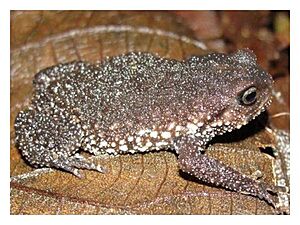Taita warty frog facts for kids
Quick facts for kids Taita warty frog |
|
|---|---|
 |
|
| Conservation status | |
| Scientific classification |
Callulina dawida, also known as the Taita warty frog, is a special type of frog. It belongs to the family called Brevicipitidae. This frog lives only in Kenya, specifically in the Taita Hills. It can only be found in small, separate parts of the montane forests there. Scientists first thought there was only one type of Callulina frog. But in the last ten years, they have found eight new species! Many of these new species are now in danger of disappearing. C. dawida was officially named in 2009. Its name comes from the Dawida language, which people speak in the Taita Hills.
Contents
What Does It Look Like?
The Taita warty frog is a medium-sized frog. Female frogs can grow up to 55 millimeters (about 2.2 inches) long. Male frogs are a bit smaller, reaching about 35 millimeters (about 1.4 inches).
Their back feet have toes that can move in two different ways. The fourth and fifth toes point backward when the frog walks on the forest floor. This helps them move around.
The frog's skin is bumpy, which is why it's called "warty." The color of adult frogs can change a lot. They might be light brown, grey, dark brown, orange, or even yellowish. Both male and female frogs can have these colors. Male frogs have a larger tympanum (like an eardrum) than females.
Where Does It Live?
The Taita warty frog lives high up in the mountains. It can be found in natural forest areas above 1400 meters (about 4600 feet). These areas are in the Dawida and Mbololo parts of the Taita Hills.
You will find more of these frogs at higher altitudes. They do not live in farmlands or tree plantations. The frogs are most active when it's warm, from January to March and August to October. They are less active during the colder months of June and July. They also slow down during the main rainy seasons in April and November/December. July is the coldest month in the Taita Hills for them.
The Taita warty frog likes to be alone. It does not move around much, which helps it survive in small forest patches. These frogs are good climbers. They can climb more than 1 meter (about 3 feet) high on tree trunks.
Life Cycle and Reproduction
Taita warty frogs start to breed mainly during the long dry season, usually around July. The male frog makes a fast, repeated "brrr brr brr..." sound. This call helps attract females.
The female frog lays her eggs in September. She places them in nests made of leaves on the ground. The mother frog stays with her eggs for about three months, until November. Like other frogs in its family, Callulina dawida lays a small number of large eggs. These eggs have a lot of yolk, which provides food for the baby frogs. The eggs are also surrounded by jelly-filled capsules. This might help protect the fertile eggs from drying out during the dry season.
The eggs hatch at different times. The young frogs leave the nest right away. After hatching around November, the young frogs are big enough to move around. You can easily spot them in January and February. The Taita warty frog becomes old enough to breed itself within eight months of hatching.
Protecting This Frog
The IUCN has listed the Taita warty frog as a critically endangered species. This means it is in great danger of disappearing forever. Its home is small and broken up into many pieces. Also, its habitat is getting worse and smaller over time.
There are plans to help this frog. People want to replace some pine and eucalyptus tree farms with native tree species. This will help bring back the natural forest that the Taita warty frog needs to survive.


